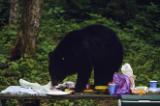 © Bruce McNitt/Panoramic Images (Virginia)
© Bruce McNitt/Panoramic Images (Virginia)

Habitat Loss in Virginia
The greatest threat to Virginia’s biodiversity comes from the loss and degradation of suitable habitat. Across the state, land is being converted to more intensive uses. In particular woodlands and pastures are being converted to subdivisions and shopping centers, and new roads and utility corridors are being constructed to service them. Current estimates indicate that over 93,000 acres of Virginia’s open space lands are converted to non-renewable uses each year.
The Virginia Natural Heritage Program contributes in a number of ways to help protect sensitive habitats from these threats. The most direct method is through land acquisition for the Natural Area Preserve System. This is especially effective for rare species and communities – such as limestone barrens – that can persist in small isolated pockets and that are not greatly affected by activities beyond the boundaries of the preserve. Land acquisition is less effective for many aquatic and cave habitats because they are often affected by events throughout large watersheds.
DCR’s project review process plays an important role in protecting these and other sensitive habitats. By reviewing development proposals the Natural Heritage Program offers guidance on the location and design of projects to help avoid or minimize impacts to natural heritage resources. The program’s karst protection staff help reduce impacts to cave systems by educating the public on the sensitive nature of these resources and by providing guidance to localities on matters such as storm water drainage systems.
Habitat Fragmentation
Development and the accompanying infrastructure, such as roads and power line rights-of-way, may threaten biodiversity through habitat fragmentation. Although suitable habitat may remain intact, the populations of some species such as forest nesting neotropical migrant birds will decline due to several factors. First, some species instinctively seek large undisturbed tracts for breeding – without large enough habitat, they simply will not breed. Second, when some plant and animal populations become isolated, they may suffer from problems associated with in-breeding. Third, the species that remain in small patches of habitat are often vulnerable to predation or invasion from “edge species.” For example, opossums and raccoons that thrive at the edge of a forest may prey heavily on the eggs and nestlings of forest birds whose habitat has been reduced to small patches. And fourth, habitat fragmentation opens up new avenues and opportunities for the introduction of invasive species.
The Virginia Natural Heritage Program plays a vital role in reducing the effects of habitat fragmentation. With its extensive database on the locations of critical habitats, its GIS capabilities, and the expertise of its staff, the Natural Heritage Program can help guide development and land protection efforts, in order to preserve the biological integrity of large areas. One recent example is the Natural Heritage Program’s contribution to the Southern Watershed Area Management Program (SWAMP), which identified significant conservation corridors for the cities of Virginia Beach and Chesapeake.
Combatting Habitat Loss in Virginia
-
Crow's Nest Natural Area Preserve
The state's newest natural area in Stafford County marks the first step in a decades-long effort to provide recreational access and preserve globally significant natural communities in a storied landscape.







